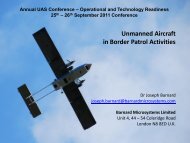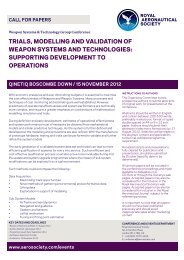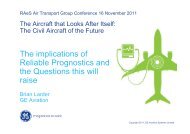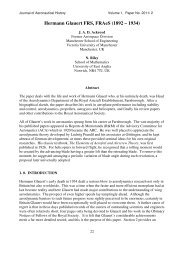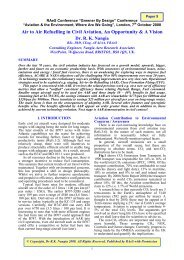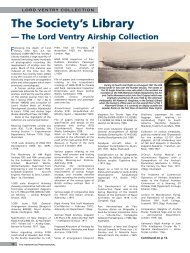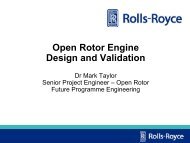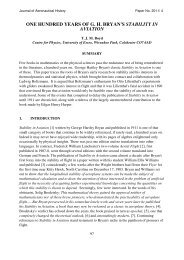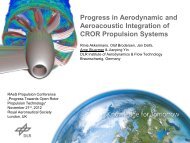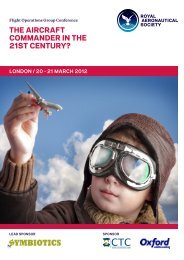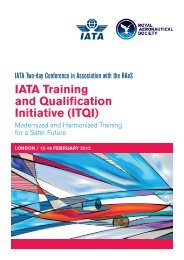safety regulation - the first 100 years - Royal Aeronautical Society
safety regulation - the first 100 years - Royal Aeronautical Society
safety regulation - the first 100 years - Royal Aeronautical Society
Create successful ePaper yourself
Turn your PDF publications into a flip-book with our unique Google optimized e-Paper software.
Journal of <strong>Aeronautical</strong> History Paper No. 2011/ 3<br />
SAFETY REGULATION - THE FIRST <strong>100</strong> YEARS<br />
J. C. Chaplin C.B.E., F.R.Eng., F.R.Ae.S.<br />
Formerly Civil Aviation Authority<br />
SUMMARY<br />
The <strong>safety</strong> <strong>regulation</strong> of aviation began in Great Britain <strong>100</strong> <strong>years</strong> ago. This paper traces <strong>the</strong><br />
major stages in <strong>the</strong> development of <strong>regulation</strong> from that earliest step up to <strong>the</strong> formation of <strong>the</strong><br />
European Aviation Safety Authority (EASA).<br />
The interplay between <strong>the</strong> regulatory authority and <strong>the</strong> industry which it regulated is described<br />
and <strong>the</strong> interaction with <strong>the</strong> various supra-national bodies such as ICAN and ICAO is set out.<br />
Examples are given of <strong>the</strong> way in which accidents have helped to shape standards.<br />
Throughout <strong>the</strong> early development of aviation a lot of attention was devoted to airworthiness, so<br />
<strong>the</strong>re is much emphasis on it in this paper. However, most accidents have historically originated<br />
in operational causes and <strong>the</strong> broad steps in operational <strong>regulation</strong> are also described.<br />
The factors which drove <strong>the</strong> development of <strong>the</strong> European Joint Aviation Authorities are<br />
examined, and <strong>the</strong> paper also sets out <strong>the</strong> broad structure of EASA when it <strong>first</strong> commenced its<br />
role.<br />
1. Introduction<br />
Aviation and <strong>regulation</strong> seem to go hand in hand, and many may feel that, if anything,<br />
aviation suffers from a surfeit of control. Of course, <strong>the</strong> situation that we see today<br />
was not created overnight. Ra<strong>the</strong>r it is <strong>the</strong> end product of a continually developing<br />
situation and <strong>the</strong> history of that development, interesting in its own right, is also a<br />
useful guide as to why things are <strong>the</strong> way <strong>the</strong>y are. At a time when great changes to<br />
<strong>the</strong> process of <strong>regulation</strong> in Europe have taken place, a review of history can form -<br />
<strong>the</strong> basis of a useful check list to ensure that nothing of significant value has been<br />
lost in <strong>the</strong> change. Aviation is good at learning lessons from experience. Regrettably<br />
from time to time it has also forgotten one or two!<br />
Any historical review of a <strong>100</strong>-year period can only be cursory if it is to be<br />
contained in a short paper. To limit <strong>the</strong> scope somewhat, this presentation will<br />
conclude with <strong>the</strong> formation of <strong>the</strong> EASA. None-<strong>the</strong>-less, it will only be possible to<br />
touch on some of <strong>the</strong> highlights, and inevitably one person's highlight may be of<br />
minor interest to someone else. But <strong>the</strong> broad framework of development can, it is<br />
hoped, be shown.<br />
75
Journal of <strong>Aeronautical</strong> History Paper No. 2011/ 3<br />
The form and content of <strong>regulation</strong> can take many forms, as <strong>the</strong> differences which<br />
have existed between UK and US requirements well illustrate. The main thrust of<br />
aviation development, <strong>the</strong> interests of industry in developing certain types of<br />
aircraft, <strong>the</strong> general legal framework within which <strong>the</strong> system has to operate, and<br />
most importantly <strong>the</strong> people involved all play <strong>the</strong>ir part, as does <strong>the</strong> international<br />
environment and some of <strong>the</strong>se threads will be explored in <strong>the</strong> present paper.<br />
2. First Steps in Great Britain<br />
Formal control of civil aviation in Great Britain began with <strong>the</strong> Aerial Navigation<br />
Act of 1911. Civil aviation law became <strong>the</strong> responsibility of <strong>the</strong> Home Office, and<br />
<strong>the</strong> sole concern was <strong>the</strong> protection of people on <strong>the</strong> ground. The Act also gave <strong>the</strong><br />
Board of Trade responsibilities relating to <strong>the</strong> registration and certification of<br />
aircraft and pilots. However, <strong>the</strong> Aerial Navigation Act of 1913 transferred control<br />
to <strong>the</strong> Secretary of State for War. It was largely concerned with defence matters, and<br />
introduced prohibited areas, corridors of entry and compulsory landing grounds. The<br />
1914-1918 conflict brought with it a ban on civil aviation except for flights within<br />
three miles of a recognized aerodrome. In 1916 an Air Board was formed which was<br />
to play a significant part in <strong>the</strong> post-war control of civil aviation.<br />
3. Post World War I<br />
The experiences of war and <strong>the</strong> considerable development of aviation during <strong>the</strong> wartime<br />
<strong>years</strong> clearly suggested that civil aviation had a role to play, and that some form<br />
of governmental control would be necessary. In <strong>the</strong> months following <strong>the</strong> Armistice<br />
in 1918 a number of <strong>regulation</strong>s were put in place so that civil flying could officially<br />
recommence on 1st May 1919 under <strong>the</strong> supervision of a Department of Civil<br />
Aviation, <strong>the</strong> formation of which had been announced to Parliament on February<br />
12th 1919. The <strong>first</strong> Controller General of Civil Aviation was F H Sykes (later Sir<br />
Frederick) and it is interesting to note some of <strong>the</strong> information contained in his <strong>first</strong><br />
(initially 6-monthly) "Synopsis of Progress of Work in <strong>the</strong> Dept. of Civil Aviation,<br />
1st May 1919 to 31st October 1919 " 1 .<br />
Table 1<br />
Number of hours flown 4,000<br />
Number of flights 21,000<br />
Number of passengers 52,000<br />
Approximate mileage 30,300<br />
Number of accidents 13<br />
Number of fatal accidents 2<br />
76
Journal of <strong>Aeronautical</strong> History Paper No. 2011/ 3<br />
Table 2<br />
Total<br />
Number<br />
77<br />
Per <strong>100</strong>0<br />
flights<br />
Per <strong>100</strong>0<br />
hours flown<br />
Pilots killed 2 0.095 0.5<br />
Pilots injured 6 0.286 1.5<br />
Pass. killed 0 0 0<br />
Pass. injured 10 0.476 2.5<br />
It was possible, <strong>the</strong>refore, for Mr Sykes to report that "for every 5,200 passengers<br />
carried only 1 has been injured."<br />
Provisional arrangements had been made for British commercial aircraft to visit<br />
Amsterdam, Brussels, Christiania, Copenhagen, Lausanne, Madrid, Paris and<br />
Stockholm.<br />
Considerable attention was paid in this <strong>first</strong> report, as in many subsequent ones, to<br />
<strong>the</strong> development of Imperial Air Routes, which though not directly relevant to <strong>the</strong><br />
issue of <strong>safety</strong> <strong>regulation</strong> undoubtedly coloured <strong>the</strong> thinking of those concerned - as<br />
exemplified some <strong>years</strong> later by <strong>the</strong> development of airships with <strong>the</strong>ir attendant<br />
problems.<br />
In addition to noting <strong>the</strong> introduction of <strong>the</strong> Air Navigation Regulations, ano<strong>the</strong>r<br />
positive step towards easing <strong>the</strong> task of navigation was noted. Names were marked<br />
on <strong>the</strong> roofs of <strong>the</strong> railway stations at Ashford, Hitchin, Redhill and Tonbridge.<br />
Some might welcome a continuation of that practice today, though doubtless <strong>the</strong>re<br />
would be an argument as to who should pay for <strong>the</strong> work!<br />
Along somewhat similar lines, when <strong>the</strong> decision was taken to operate a regular air<br />
service between Palestine and Iraq, which was approved by a conference in Cairo in<br />
1921 and was to be operated by <strong>the</strong> RAF, <strong>the</strong> advantages to navigation which came<br />
from <strong>the</strong> ability to follow railway lines were noted. No such facility existed<br />
between Aman and Ramadi, <strong>the</strong> two points to be linked. The decision was taken to<br />
emulate a railway by ploughing a furrow through <strong>the</strong> desert between <strong>the</strong>m, a<br />
distance of 470 miles. This was duly done, and <strong>the</strong> RAF “flew <strong>the</strong> furrow” for 5 ½<br />
<strong>years</strong>.<br />
In his autobiography 2 Sir Frederick Sykes notes "By dint of superhuman exertions,<br />
we managed to get <strong>the</strong> British Air Navigation Regulations for Civil Flying in <strong>the</strong><br />
United Kingdom by April 30 (1919). They included rules for <strong>the</strong> registration of<br />
aircraft and <strong>the</strong> licensing of personnel, <strong>the</strong> certification of airworthiness for<br />
passenger aircraft and <strong>the</strong>ir periodic overhaul and examination, registration and<br />
nationality marks, log-books, prohibited a r e a s , rules of <strong>the</strong> air, lights and<br />
signals, and customs <strong>regulation</strong>s and o<strong>the</strong>r rules for aircraft arriving at and
Journal of <strong>Aeronautical</strong> History Paper No. 2011/ 3<br />
departing from British Airports. Our work was made all <strong>the</strong> harder by <strong>the</strong> fact that<br />
<strong>the</strong>se <strong>regulation</strong>s were quite novel, and <strong>the</strong>re were no precedents which we could<br />
follow."<br />
4. Uneasy Progress<br />
The <strong>years</strong> from 1919 to 1937 were marked by some remarkably perceptive thoughts<br />
and actions, coupled with a strong feeling in <strong>the</strong> manufacturing industry of being<br />
stifled and held back by <strong>the</strong> system of control implemented by government.<br />
Attempts to consult industry <strong>the</strong>re certainly were. For example, in late 1919 <strong>the</strong><br />
Controller General of Civil Aviation wrote to <strong>the</strong> SBAC asking for <strong>the</strong> <strong>Society</strong>'s<br />
views on <strong>the</strong> value of homing pigeons for civil aviation, as <strong>the</strong> RAF pigeon service<br />
was being disbanded. In <strong>the</strong> <strong>Society</strong> of British Aircraft Constructors' (SBAC)<br />
record of points discussed with <strong>the</strong> Controller General, it is recorded "The <strong>Society</strong><br />
considers <strong>the</strong>se are too expensive to be used in civil aviation. Effective wireless is<br />
preferred." It is perhaps surprising that <strong>the</strong> rejection was on cost grounds ra<strong>the</strong>r<br />
than those of speed and reliability.<br />
It is clear from contemporary documents that much thought was being devoted to<br />
<strong>safety</strong> matters both within and outside <strong>the</strong> Air Ministry.<br />
For example, in 1920 in his book "Aerial Transport" 3 , Mr G Holt Thomas wrote:<br />
"The argument that flying is inherently dangerous cannot in fact be substantiated.<br />
Just recently, since <strong>the</strong> Armistice, <strong>the</strong> Air Ministry's figures show that, for every<br />
fatal accident which takes place, more than 40,000 miles are flown in <strong>safety</strong>; and<br />
this figure is certain to be improved very greatly in <strong>the</strong> near future." He adds "It<br />
should be an elementary rule that those who fly do so without causing annoyance or<br />
risk to those remaining on <strong>the</strong> ground." Perhaps today <strong>the</strong>re is a somewhat different<br />
view of <strong>the</strong> absolute numbers to strive for, but it is clear from this quotation that <strong>the</strong><br />
concepts which are familiar today were in mind.<br />
And again, in October 1922, Sir Sefton Brancker, who by <strong>the</strong>n was Director of Civil<br />
Aviation, wrote "We have two immediate ends to attain in connection with<br />
navigation:<br />
1. Eliminate engine trouble<br />
2. Perfect <strong>the</strong> wireless.<br />
Both are possible - and quite soon." 4<br />
Somewhat optimistic, perhaps, but none <strong>the</strong> less forward looking.<br />
78
Journal of <strong>Aeronautical</strong> History Paper No. 2011/ 3<br />
By October 1925, Sir Sefton was able to present to <strong>the</strong> <strong>Royal</strong> <strong>Aeronautical</strong> <strong>Society</strong> s<br />
an analysis of, as he put it "various sources of danger" toge<strong>the</strong>r with some proposed<br />
solutions. He listed <strong>the</strong>se as follows:<br />
Breakage of <strong>the</strong> aircraft itself in <strong>the</strong> air - possible solutions - simplicity of<br />
design, vital members to be easily seen and easy of access, and concern was<br />
expressed about metal fatigue. Sir Sefton was convinced that all metal aeroplanes<br />
were essential, and that all too little was known about <strong>the</strong> fatigue of such structures.<br />
Jamming or failure of controls - again simplicity of design was proposed, toge<strong>the</strong>r<br />
with careful inspection. Sir Sefton noted that a <strong>regulation</strong> had been introduced<br />
prohibiting passengers from <strong>the</strong> cockpit, aimed at eliminating <strong>the</strong> risk of<br />
interference with <strong>the</strong> controls.<br />
Fire - fireproof bulkheads were called for.<br />
Powerplant failure - three engines were seen as desirable, because aircraft could<br />
not sustain flight if one of only two engines failed.<br />
Error of judgement - <strong>the</strong> palliative to this problem, acknowledged as a major one,<br />
was to be two-fold - careful selection, good discipline and sound <strong>regulation</strong>s on <strong>the</strong><br />
one hand and, from 1st January 1926, carriage of two crew on all aircraft capable of<br />
carrying more than 10 passengers. The second man was to have, as his <strong>first</strong> duty,<br />
operation of <strong>the</strong> wireless. The question of provision of dual controls was unresolved,<br />
since many pilots objected, but <strong>the</strong> second crew member must be able to change<br />
places with <strong>the</strong> pilot easily. It was noted with regret that <strong>the</strong> comfort of <strong>the</strong> pilot<br />
and ease of handling had given way to demands for performance.<br />
Adverse wea<strong>the</strong>r - it was envisaged that a reliable powerplant combined with<br />
efficient wireless navigation would eliminate <strong>the</strong> dangers of darkness and fog. The<br />
snow problem could be solved by <strong>the</strong> use of air intakes designed to prevent choking,<br />
and as to lightning, more study was needed.<br />
Collision - rules were in place for clear wea<strong>the</strong>r, but as night flying increased, some<br />
form of automatic warning of <strong>the</strong> approach of ano<strong>the</strong>r machine was needed.<br />
The 1925 report from <strong>the</strong> Department of Civil Aviation adds to <strong>the</strong>se points.<br />
Requirements for take off and landing had been formulated and were operative for<br />
landplanes. Experiments were proceeding from which it was hoped to derive<br />
stability and controllability requirements.<br />
In <strong>the</strong> foregoing, <strong>the</strong> greatest emphasis is placed on <strong>the</strong> aircraft itself, and<br />
airworthiness seemed to be at <strong>the</strong> forefront of minds, even though it was recognised<br />
that operational matters, in particular pilot ability, played a large part in <strong>the</strong> <strong>safety</strong><br />
level achieved. That is not to say that some operational <strong>regulation</strong>s were put in<br />
79
Journal of <strong>Aeronautical</strong> History Paper No. 2011/ 3<br />
place. For example, it is noted in <strong>the</strong> 1927 report "In <strong>the</strong> event of bad wea<strong>the</strong>r<br />
conditions, and in particular in <strong>the</strong> case of very low clouds and fog a system of<br />
alternative routes for machines approaching and departing from Croydon has been<br />
put into force. This has been done to try and prevent any possibility of collision<br />
between aircraft caused by bad visibility." 6<br />
However, on ano<strong>the</strong>r front, <strong>the</strong>re was less happiness with progress. In a comment in<br />
1941, Mr T R Thomas, <strong>the</strong> <strong>first</strong> secretary of <strong>the</strong> Air Registration Board, wrote: "In<br />
<strong>the</strong> early days of Civil Aviation, suggestions were made that Civil Aviation would<br />
not develop to its full stature so long as it was subject to <strong>the</strong> strong influence of<br />
Service Aviation. Mr Handley Page had taken every opportunity of propagating <strong>the</strong><br />
idea of a divorce of Civil and Service aviation, and it was mainly due to <strong>the</strong><br />
influence of his efforts that an interdepartmental committee was set up in <strong>the</strong> late<br />
twenties under <strong>the</strong> chairmanship of J S Ross."<br />
5. Devolution<br />
By mentioning <strong>the</strong> Ross committee, we are taking <strong>the</strong> story somewhat ahead of itself.<br />
Attempts had been made earlier to devise some degree of devolution of <strong>the</strong> task of<br />
controlling civil aviation. In 1920 Lloyds Register had set up an Aviation<br />
Department to provide a system of classification of aircraft and to compile a register<br />
of aircraft and pilots. The cost of this work was to be met by Lloyds, by<br />
subscriptions from insurance companies and by payments for copies of <strong>the</strong> register.<br />
In <strong>the</strong> event, <strong>the</strong> cost was not covered, and so <strong>the</strong> Treasury subsidised <strong>the</strong> work "up<br />
to a cost of £625". In January 1927, this work was dropped because of a lack of<br />
outside financial support. However, <strong>the</strong> work was carried forward by <strong>the</strong> British<br />
Corporation for Shipping which was approved to compile an International Register<br />
of Commercial Aircraft in <strong>the</strong> same month.<br />
In November 1928, Sir Sefton Brancker wrote 7 on <strong>the</strong> subject of devolution:<br />
"Personally, I am anxious to see a start made along <strong>the</strong> lines proposed, for several<br />
reasons.<br />
1 The increase in <strong>the</strong> number of British civil aircraft operating in <strong>the</strong> country<br />
and in o<strong>the</strong>r parts of <strong>the</strong> world will be considerable during <strong>the</strong> next two or<br />
three <strong>years</strong>.<br />
2. I feel that Government control of civil aviation should be limited to <strong>the</strong><br />
lowest measure possible, with due consideration to our International<br />
responsibilities and <strong>the</strong> <strong>safety</strong> of <strong>the</strong> public.<br />
3. The history of shipping has proved that a policy on <strong>the</strong>se lines is sound.”<br />
Clearly, <strong>the</strong>n, at a senior level in <strong>the</strong> Civil Service, <strong>the</strong> idea of devolving control of at<br />
80
Journal of <strong>Aeronautical</strong> History Paper No. 2011/ 3<br />
least some aspects of civil aviation was welcomed.<br />
By July 1929, <strong>the</strong> British Aviation Insurance Group (BAIG) had been given<br />
approval to deal with <strong>the</strong> general classification of aircraft, <strong>the</strong> inspection of light<br />
aircraft and recommendations for <strong>the</strong> renewal of certificates of airworthiness. But<br />
this approval was not extended to public transport aircraft. The British Corporation<br />
was given similar approval. This, however was not implemented by BAIG as Lloyds<br />
agreed to set up its own organisation. BAIG withdrew, and Lloyds was given<br />
approval in September 1929.<br />
In 1930, both organisations applied to <strong>the</strong> Secretary of State for an extension to <strong>the</strong>ir<br />
role, and in a letter dated 14th August 1931, Lloyds spelled out <strong>the</strong>ir request as<br />
follows.<br />
"Inspection of all civil aircraft for renewal of Certificates of Airworthiness:<br />
Inspection at Constructor's works of all aircraft and engines: Issue of Airworthiness<br />
Certificates<br />
Approval of Design of civil type aircraft and engines and inspection during<br />
construction:<br />
Approval of modifications for civil aircraft: Registration of civil aircraft:<br />
Inspection of materials, equipment, aircraft and engines for foreign orders:<br />
Supervision of ground engineers.” "<br />
This was a very ambitious shopping list which was not, in <strong>the</strong> event, devolved wholly<br />
from Government until <strong>the</strong> Civil Aviation Authority was formed in 1972. Hardly<br />
surprising, <strong>the</strong>refore, that <strong>the</strong> proposal did not get automatic acceptance.<br />
In 1930 a committee had been established under <strong>the</strong> chairmanship of Air Commodore<br />
F V Holt (Director of Technical Development) "To enquire into <strong>the</strong> present<br />
difficulties experienced by British Aircraft Constructors in connection with <strong>the</strong><br />
certification of aircraft for airworthiness, as affecting such Constructors'<br />
commercial interests, particularly in relation to foreign trade; and to make<br />
recommendations for <strong>the</strong> revision if necessary of <strong>the</strong> existing procedure and<br />
requirements." The membership of this committee included representatives of <strong>the</strong><br />
SBAC and Imperial Airways. It had before it a lengthy and detailed submission from<br />
<strong>the</strong> SBAC drawing attention to <strong>the</strong> large number of different standards which an<br />
aircraft had to meet, and to <strong>the</strong> costly and complicated machinery needed to put <strong>the</strong>m<br />
into operation. Also, "The Air Ministry lays down Requirements on matters regarding<br />
which <strong>the</strong>re is little or no experience, thus suppressing initiative and retarding <strong>the</strong><br />
development of civil aircraft." 8<br />
81
Journal of <strong>Aeronautical</strong> History Paper No. 2011/ 3<br />
Many of <strong>the</strong> points made in <strong>the</strong> submission would doubtless find echoes today, though <strong>the</strong>re<br />
would be unlikely to be complete agreement with <strong>the</strong>m all. For example, "There appears<br />
to be confusion in <strong>the</strong> minds of Air Ministry Officials as to what constitutes airworthiness and<br />
what is a desirable commercial feature." The report <strong>the</strong>n cites requirements for <strong>the</strong><br />
strength of Safety Belts and Harnesses as an example. Today <strong>the</strong>se are regarded as part of <strong>the</strong><br />
airworthiness of <strong>the</strong> aircraft.<br />
Never<strong>the</strong>less, <strong>the</strong> final report to <strong>the</strong> Secretary of State in February 1931 agreed that<br />
<strong>the</strong> present procedure did in some respects hamper aircraft firms in a manner which<br />
was sometimes detrimental to <strong>the</strong>ir commercial interests, and went on to make a<br />
number of recommendations aimed at simplifying and easing <strong>the</strong> procedures. In<br />
particular, it was recommended that it be recognised that <strong>the</strong> responsibility for <strong>the</strong><br />
satisfactory design and construction of aircraft devolved upon <strong>the</strong> approved firms<br />
with a consequent reduction in <strong>the</strong> extent to which <strong>the</strong> Resident Technical Officer<br />
(RTO) need involve himself in detailed checking. The firm's report that <strong>the</strong> aircraft<br />
design and construction met requirements should be accepted.<br />
There were o<strong>the</strong>r important recommendations, of which but two are selected.<br />
Flying trials should be conducted at an official testing station or at <strong>the</strong> constructor's<br />
aerodrome, using <strong>the</strong> constructor's pilot for many of <strong>the</strong> tests.<br />
The Civil Airworthiness Committee should be extended to include representatives of<br />
industry, SBAC, users and insurance interests to advise <strong>the</strong> Air Ministry on all<br />
matters affecting airworthiness <strong>regulation</strong>s.<br />
The Ross Committee was established to report on <strong>the</strong> policy of delegating duties<br />
connected with inspection of civil aircraft to one or more outside bodies. It<br />
comprised only officials as members, and its report was never published, though it<br />
is available today from <strong>the</strong> Public Records Office. The files contain much<br />
correspondence about <strong>the</strong> desirability of such a change, <strong>the</strong> associated problems and<br />
<strong>the</strong> costs. The committee made some sweeping suggestions, and such was <strong>the</strong> nature<br />
and complexity of <strong>the</strong> points which arose that it was decided to set up a fur<strong>the</strong>r<br />
committee, drawing members from all interested parties, under <strong>the</strong> Chairmanship of<br />
Lord Gorell. The o<strong>the</strong>r members were Captain Harold Balfour, Mr E C Gordon<br />
England, Mr W Lindsay Everard, Lt.Col J T C Moore-Brabazon, Mr F Handley Page<br />
and Mr W A Workman. The committee was established in 1933, and its conclusions<br />
will be set out later in this section.<br />
First, however, a short diversion. In <strong>the</strong> foregoing history, a reader might be excused<br />
for drawing two conclusions. Firstly, that it was <strong>the</strong> needs of <strong>the</strong> manufacturing<br />
industry which drove development, with <strong>the</strong> operational side barely getting mention,<br />
and secondly that experience of real operations was playing little part in helping to<br />
formulate ei<strong>the</strong>r <strong>the</strong> <strong>regulation</strong>s or <strong>the</strong> shape of <strong>the</strong> controlling machinery.<br />
82
Journal of <strong>Aeronautical</strong> History Paper No. 2011/ 3<br />
Such conclusions would not be entirely fair. Part of <strong>the</strong> difficulty stems from practice at <strong>the</strong><br />
time. Reports of accidents, where <strong>the</strong>y existed as separate documents, did not make<br />
recommendations as such, and we are left with somewhat generalised conclusions - as set out,<br />
for example, in Sir Sefton Brancker's paper, already discussed - to see <strong>the</strong> impact of<br />
accidents and incidents on <strong>regulation</strong>. In some cases, it is difficult to make a<br />
positive statement as to <strong>the</strong> influence an accident may have had. But before <strong>the</strong><br />
Gorell Committee was formed, <strong>the</strong>re had been <strong>the</strong> R 101 accident, and this was <strong>the</strong><br />
subject of a detailed report 9 . In its consideration of <strong>the</strong> events leading up to that<br />
accident, that report contains <strong>the</strong> following passage:<br />
"It is clear that if those responsible had been entirely free to choose <strong>the</strong> time and<br />
<strong>the</strong> wea<strong>the</strong>r in which <strong>the</strong> R101 should start for <strong>the</strong> <strong>first</strong> flight ever undertaken by<br />
any airship to India, and if <strong>the</strong> only consideration governing <strong>the</strong>ir choice were<br />
considerations of meteorology and of preparation for <strong>the</strong> voyage, <strong>the</strong>n <strong>the</strong> R101<br />
would not have started when she did.<br />
"It is impossible to avoid <strong>the</strong> conclusion that <strong>the</strong> R101 would not have started for<br />
India on <strong>the</strong> evening of October 4th if it had not been that reasons of public policy<br />
were considered as making it highly desirable for her to do so if she could.<br />
"...it must always have been difficult for <strong>the</strong> distinguished officers at Cardington<br />
who sailed in <strong>the</strong> R101 to resist <strong>the</strong> strongly expressed urging of <strong>the</strong> Secretary of<br />
State...."<br />
A report on a similar accident today would doubtless draw some recommendations<br />
from <strong>the</strong> foregoing. The report as published contents itself with <strong>the</strong> observations. It<br />
may have been, however, that <strong>the</strong> views of <strong>the</strong> Gorell Committee were coloured to<br />
some degree by <strong>the</strong> thought that <strong>the</strong>re could be merit in separating <strong>safety</strong> and<br />
politics. If so, that may help to explain why <strong>the</strong> development of aviation <strong>regulation</strong><br />
in <strong>the</strong> UK followed a path largely different from <strong>the</strong> rest of <strong>the</strong> world in moving<br />
responsibility away from <strong>the</strong> direct control of politicians.<br />
Be that as it may, <strong>the</strong> Gorell Committee duly reported, 10 and made a total of 18<br />
recommendations, <strong>the</strong> majority of which were accepted by <strong>the</strong> Air Council. The report<br />
includes an interesting analysis of <strong>the</strong> causes of accidents to civil aircraft on <strong>the</strong> Air<br />
Ministry Register for <strong>the</strong> period 1926 - 1933 which sets <strong>the</strong> background against<br />
which <strong>the</strong> report was written.<br />
83
Journal of <strong>Aeronautical</strong> History Paper No. 2011/ 3<br />
Table 3 Analysis of Accidents - Gorell Report<br />
Total number of Accidents 355 1926 - 1933<br />
Category A 258 Cases in which no part of aircraft or power-plant was in any way<br />
at fault<br />
Category B 60 Cases in which engine failure occurred taking-off or in flight,<br />
including shortage of fuel in tank, misuse of engine controls, etc<br />
Category C 23 Cases in which <strong>the</strong> aircraft was, or became, defective in flight for<br />
any reason apart from power-plant failure. Cases of structural<br />
failure, faulty control gear, fire in air, etc<br />
Category D 15 Cases of exceptional nature or indeterminable<br />
258 Accidents, or 72.3 per cent of total number<br />
Category A<br />
(a) 177 Errors of airmanship alone, including possible cases of pilot's physical<br />
disability<br />
(b) 20 Bad wea<strong>the</strong>r conditions<br />
(c) 38 Collision with o<strong>the</strong>r aircraft, overhead cables, telegraph wires, trees, buildings,<br />
etc., in conditions of reasonably good visibility<br />
(d) 16 Use of unsuitable aerodromes and landings on bad ground<br />
(e) 7 Interference with dual controls by passengers, ei<strong>the</strong>r accidental or intentional<br />
60 accidents, or 16.9 per cent of total number<br />
Category B<br />
(a) 29 Engine failure followed by errors of airmanship<br />
(b) 31 Engine failure in circumstances likely to lead to accident<br />
22 accidents, or 6.1 per cent of total number<br />
Category C<br />
(a) 9 Structural failure of aircraft<br />
(b) 2 Unsatisfactory aerodynamic qualities of machine<br />
(c) 9 Defective aero-controls<br />
(d) 2 Outbreak of fire in <strong>the</strong> air<br />
Although <strong>the</strong> detail differs, possibly in part at least because of <strong>the</strong> particular<br />
categories used, <strong>the</strong> overall conclusion is not so different to that shown by analysis<br />
of today's accidents - that is, <strong>the</strong> majority are due to causes o<strong>the</strong>r than airworthiness.<br />
The Gorell Committee noted this in one of its conclusions:<br />
"Entirely wrong values have been placed upon <strong>the</strong> relative importance of <strong>the</strong> pilot,<br />
84
Journal of <strong>Aeronautical</strong> History Paper No. 2011/ 3<br />
<strong>the</strong> machine and operational activities, in arriving at <strong>the</strong> <strong>regulation</strong>s to be<br />
imposed. The failure of <strong>the</strong> pilot is by far <strong>the</strong> most potential source of accidents in<br />
flying."<br />
It is somewhat surprising, <strong>the</strong>refore, that <strong>the</strong> Committee made no significant<br />
recommendations on <strong>the</strong> subject of operational controls, which would have been<br />
within <strong>the</strong>ir terms of reference. They made a number of recommendations on <strong>the</strong><br />
need for certificates of airworthiness in certain cases, recommended that third party<br />
insurance should be compulsory, advised that towed gliders and gliders carrying<br />
passengers for hire and reward should hold certificates of airworthiness and that<br />
<strong>the</strong>ir pilots should be licensed, considered that it was inappropriate to attempt to<br />
impose restrictions on Sunday flying, and recommended that <strong>the</strong> control of<br />
airworthiness of civil aircraft should be devolved to a statutory autonomous Board<br />
t o b e formed from <strong>the</strong> Joint Aviation Advisory Committee of Lloyd's Register and<br />
<strong>the</strong> British Corporation Register. In making this last recommendation - suggesting<br />
that <strong>the</strong> new Board should be called <strong>the</strong> Air Registration Board - <strong>the</strong> Committee<br />
also recommended that <strong>the</strong> Board should receive an annual grant to cover part of its<br />
costs in <strong>the</strong> early <strong>years</strong> of its work but that it should aim to become self-supporting.<br />
The Committee in its report made two observations of particular interest. They said<br />
"We agree with <strong>the</strong> pronouncement in <strong>the</strong> Ross Committee report that '<strong>the</strong> policy of<br />
control of private flying . . . cannot be settled in isolation; <strong>the</strong> future control of civil<br />
aviation in respect of all airworthiness matters must be considered as a whole." In<br />
ano<strong>the</strong>r remark, <strong>the</strong>y said "We feel <strong>the</strong>re is substance in <strong>the</strong> representations of <strong>the</strong><br />
SBAC and o<strong>the</strong>rs . . " and after listing <strong>the</strong> various grievances go on to say "without<br />
<strong>the</strong> good relations which exist between Air Ministry officials and firms, aircraft<br />
construction in present conditions would be almost impossible”.<br />
The various recommendations were largely accepted, but in <strong>the</strong> event, <strong>the</strong> two<br />
Shipping Registers which formed <strong>the</strong> JAAC declined to participate, on <strong>the</strong> grounds<br />
that unless control remained in <strong>the</strong>ir hands, <strong>the</strong>y would not be justified in using<br />
<strong>the</strong>ir resources to develop aircraft classification. This, of course, made it impossible<br />
to implement <strong>the</strong> Gorell recommendation in <strong>the</strong> terms in which it was written, but a<br />
fur<strong>the</strong>r Committee was set up under <strong>the</strong> chairmanship of Mr Handley Page (later Sir<br />
Frederick) for <strong>the</strong> purpose of drafting a scheme. The outcome of this was a blueprint<br />
for <strong>the</strong> Air Registration Board, and <strong>the</strong> ARB which came into operation in February<br />
1937 followed <strong>the</strong> proposed pattern very closely.<br />
As already remarked up to this time relatively little attention appears to have been<br />
paid to operational matters, even though, as stated by <strong>the</strong> Gorell Committee, <strong>the</strong>se<br />
gave rise to <strong>the</strong> major proportion of accidents. Mr Alec O'Connor has previously<br />
pointed out 11 that <strong>the</strong> situation was very different in <strong>the</strong> USA, where a recognition of<br />
<strong>the</strong> need for better <strong>regulation</strong> of <strong>the</strong> operational side occurred much earlier than<br />
here.<br />
85
Journal of <strong>Aeronautical</strong> History Paper No. 2011/ 3<br />
There were, however steps along <strong>the</strong> road, some already touched upon. In 1926, <strong>the</strong><br />
Under Secretary of State met <strong>the</strong> <strong>Royal</strong> Aero Club, <strong>the</strong> SBAC, insurers and o<strong>the</strong>rs to<br />
discuss proposals for <strong>the</strong> relaxation of <strong>regulation</strong>s governing private flying.<br />
Interestingly, Mr Handley Page, who usually appeared on behalf of <strong>the</strong> SBAC<br />
attended this meeting as a representative of <strong>the</strong> <strong>Royal</strong> Aero Club. There was a strong<br />
plea for a complete relaxation of <strong>the</strong> controls on private flying, and a suggestion<br />
that <strong>the</strong> medical examination could be replaced by a certificate from <strong>the</strong> applicant's<br />
own doctor that he was fit to fly. Some felt that <strong>the</strong> pilot licencing requirements<br />
could be greatly simplified.<br />
A major report of <strong>the</strong> period was that of <strong>the</strong> Maybury Committee in 1936. This<br />
Committee recommended 12 a number of organizational changes, including one that<br />
radio facilities, a meteorological organization and a comprehensive air traffic<br />
control organization adequate to secure <strong>the</strong> <strong>safety</strong> and regularity of air<br />
communications should be provided, maintained and operated by <strong>the</strong> Government<br />
without cost to aerodrome proprietors. The Committee suggested that a route network<br />
should be established which <strong>the</strong>y called <strong>the</strong> Junction Aerodrome system to avoid<br />
indiscriminate multiplication of services. They noted that independent routes joining<br />
major centres in <strong>the</strong> UK would have a route mileage of about 2900, whereas if<br />
aircraft from all <strong>the</strong>se centres flew to a common point, where <strong>the</strong> passengers<br />
presumably changed onto ano<strong>the</strong>r service to <strong>the</strong>ir ultimate destination, <strong>the</strong> mileage<br />
could be reduced to 960. The concept was derided at <strong>the</strong> time. Today it might be<br />
recognised as an early expression of <strong>the</strong> 'hub and spoke' concept, though <strong>the</strong> idea of<br />
flights between this and o<strong>the</strong>r hubs had not yet emerged.<br />
The Maybury Committee also recommended that aerodrome proprietors should be<br />
responsible for providing <strong>the</strong> necessary equipment, o<strong>the</strong>r than radio, to enable <strong>the</strong>ir<br />
aerodromes to be used in <strong>safety</strong> in all conditions of visibility. They fur<strong>the</strong>r<br />
considered that <strong>the</strong> pilots of companies engaged in air transportation should be<br />
subject to special tests of skill.<br />
One fur<strong>the</strong>r pre-WWII committee must be mentioned, <strong>the</strong> Rae Committee, charged<br />
with enquiring into <strong>the</strong> working of <strong>the</strong> Directorate of Operational Services and<br />
Intelligence in <strong>the</strong> Department of Civil Aviation. This Committee, in 1938, looked<br />
into complaints about staffing in <strong>the</strong> Operational area, and recommended a clear<br />
division between operations and o<strong>the</strong>r areas. Also, Gorell, in a 1939 report,<br />
recommended <strong>the</strong> introduction of a student pilot's licence.<br />
Before leaving <strong>the</strong> pre-war <strong>years</strong>, <strong>the</strong>re must be a comment on medical control. We<br />
have already seen that medical standards for commercial pilots had been introduced by 1919. In<br />
fact, CAP 1 was entitled "The medical examination of Civil Pilots, Navigators and Engineers".<br />
Medical examinations for "A" licence holders were introduced in 1924.<br />
The controlling organisation within <strong>the</strong> Air Ministry, <strong>the</strong> Central Medical Board,<br />
had a long history. However, as mentioned earlier, by 1926 <strong>the</strong>re were views that<br />
86
Journal of <strong>Aeronautical</strong> History Paper No. 2011/ 3<br />
standards were inappropriate, at least for private pilots. By 1938 <strong>the</strong> standards for<br />
commercial pilots had grown very stringent. Today airline pilots are able to go on in<br />
defined circumstances to <strong>the</strong> age of 65. In 1938 <strong>the</strong> limit for a commercial pilot was<br />
45, and some of <strong>the</strong> tests, such as placing <strong>the</strong> candidate on a rotating chair to test<br />
reaction to aerobatic or stunt flying, have been ei<strong>the</strong>r dropped as irrelevant or<br />
replaced by o<strong>the</strong>rs considered more appropriate.<br />
6. World War II<br />
Civil aviation of course took a back seat during <strong>the</strong> early war <strong>years</strong>, but Lamplugh<br />
(1943 and 1944) made a number of sweeping suggestions. He introduced <strong>the</strong><br />
concept of an international governmental authority and advised that civil aviation<br />
be transferred to a Ministry of Transport or of Civil Aviation. There was also <strong>the</strong><br />
Brabazon report which dealt with <strong>the</strong> future civil fleet needs, and from which flowed<br />
such aircraft as <strong>the</strong> Dove, <strong>the</strong> Marathon and, of course, <strong>the</strong> Brabazon itself. The<br />
Hildred report of 1944 reviewed <strong>the</strong> recommendations of <strong>the</strong> Maybury report in <strong>the</strong><br />
light of developments.<br />
A report in Flight dated 19th October 1944 gives a valuable contemporary view of<br />
<strong>the</strong> developing scene. Reporting <strong>the</strong> appointment of Lord Swinton to <strong>the</strong> newly<br />
created post of Minister of Civil Aviation, <strong>the</strong> report also refers to a conference in<br />
Montreal which was concerned with Empire Air Routes, and to <strong>the</strong> forthcoming<br />
conference in Chicago at which international organisation was to be discussed. At<br />
<strong>the</strong> time of this report, though <strong>the</strong>re was a Minister, <strong>the</strong>re was no Ministry of Civil<br />
Aviation, and responsibility continued to rest with <strong>the</strong> Secretary of State for Air.<br />
However, it was made clear in a debate in <strong>the</strong> Lords that <strong>the</strong>re should be an<br />
independent ministry. Subsequently Lord Beaverbrook outlined British Government<br />
policy, which was that international <strong>regulation</strong> should be imposed on civil aviation,<br />
controlled by an international authority which, it was envisaged, would lay down<br />
international standards.<br />
7. The Post-war Period<br />
An important development in <strong>the</strong> postwar period was <strong>the</strong> emergence of a more comprehensive<br />
international arrangement than had existed previously. As we just noted, a conference was<br />
held in Chicago as a result of which <strong>the</strong> UK agreed tentatively to <strong>the</strong> formulation of<br />
international requirements. The Provisional International Civil Aviation Organisation<br />
(PICAO) met for <strong>the</strong> <strong>first</strong> time in Montreal in February 1946 with <strong>the</strong> object of considering<br />
proposals for a code of airworthiness which would be internationally acceptable.<br />
The UK delegation was led by Lord Brabazon. At this meeting, a fundamental difference of<br />
view between <strong>the</strong> American and British delegations appeared. The American<br />
delegation preferred a long and detailed code based on <strong>the</strong> <strong>the</strong>n existing American code.<br />
The British delegation, fearful that this code would be too rigid for <strong>the</strong> new types of<br />
87
Journal of <strong>Aeronautical</strong> History Paper No. 2011/ 3<br />
aircraft, including jets, which were on <strong>the</strong> horizon, and with <strong>the</strong> backing of <strong>the</strong> SBAC,<br />
felt that it would be better to adopt a shorter and more general code, supplemented by a<br />
number of recommended practices, until <strong>the</strong> general code could be expanded into a<br />
more detailed one as and when experience became available. Most of <strong>the</strong> rest of <strong>the</strong><br />
members were prepared to adopt <strong>the</strong> American position, but <strong>the</strong> outcome was <strong>the</strong><br />
adoption of a relatively detailed code in sufficiently general terms to allow each<br />
national authority to exercise considerable discretion whilst maintaining <strong>the</strong><br />
common minimum standard.<br />
Thus were laid <strong>the</strong> differences in approach between UK standards and US standards<br />
which bedevilled industry for so many <strong>years</strong>. It is not possible to say who was right<br />
and who was wrong. The fact is that <strong>the</strong> situation has changed considerable over <strong>the</strong><br />
<strong>years</strong>. In 1945 <strong>the</strong> main preoccupation of <strong>the</strong> U K manufacturing industry, perhaps<br />
with <strong>the</strong>ir pre-war experiences in mind, was to avoid being inhibited in design by<br />
restrictive <strong>regulation</strong>s. More recently, a major concern has been to ensure that<br />
aircraft can be sold with minimum change to <strong>the</strong> widest possible range of countries,<br />
many of which have used US ra<strong>the</strong>r than U K standards. Moreover, <strong>the</strong> influence of<br />
operators on <strong>the</strong> shape of <strong>regulation</strong> appears to have been relatively weak in <strong>the</strong><br />
immediate postwar <strong>years</strong>. Today <strong>the</strong>y wish to be able to buy aircraft from anywhere<br />
and put <strong>the</strong>m on <strong>the</strong> appropriate register with as little change as possible.<br />
O<strong>the</strong>r factors were also relevant. In <strong>the</strong> UK an aircraft could be issued with a<br />
certificate of airworthiness if it could be shown to be “fit to fly”. The British Civil<br />
Airworthiness Requirements simply constituted a means by which that might be<br />
shown. They <strong>the</strong>refore had no legal standing. By contrast, in <strong>the</strong> US <strong>the</strong><br />
airworthiness requirements were enshrined in law, and an aircraft was entitled to a<br />
certificate when it had been shown to comply with <strong>the</strong>m. Only if <strong>the</strong> Aviation<br />
Authority could show that <strong>the</strong> law was inadequate or inappropriate in <strong>the</strong> particular<br />
case could any changed or additional requirement be imposed.<br />
At <strong>the</strong> end of <strong>the</strong> war, <strong>the</strong> responsibilities for civil aviation in <strong>the</strong> UK became<br />
fragmented, with <strong>the</strong> Ministry of Civil Aviation and <strong>the</strong> Ministry of Aircraft<br />
Production, as well as <strong>the</strong> Air Registration Board each having a particular role.<br />
Many changes in controlling Department (Transport, Civil Aviation, etc) occurred<br />
over <strong>the</strong> <strong>years</strong> up to <strong>the</strong> formation of <strong>the</strong> Civil Aviation Authority in 1972. There<br />
was, however, considerable stability in staff, even though <strong>the</strong> Ministry, Department<br />
or Board which sheltered t h e m changed. And, of course, <strong>the</strong> ARB continued<br />
throughout this period.<br />
Committees continued to consider <strong>the</strong> needs of British civil aviation, sometimes discussing<br />
structure, sometimes more technical matters: For example, <strong>the</strong> Helmore Committee (on<br />
Certification of Civil Aircraft and approval of equipment) reported in 1949 13 . One of its<br />
findings was that certification flight trials did not take account of <strong>the</strong> conditions in which an<br />
aircraft might have to be operated, and it recommended that trials should include intense<br />
endurance flying if <strong>the</strong> aircraft or powerplant was unconventional or incorporated<br />
88
Journal of <strong>Aeronautical</strong> History Paper No. 2011/ 3<br />
new design features. This flying was to be carried out in conditions as close to<br />
operational ones as practicable, and should be aimed at testing reliability during <strong>the</strong> early<br />
period when defects were likely to arise. This recommendation was accepted by <strong>the</strong><br />
Government, and <strong>the</strong> ARB undertook to apply such a requirement. Thus yet ano<strong>the</strong>r UK<br />
difference arose, for whilst <strong>the</strong> US regulators had similar concerns, <strong>the</strong>y went about<br />
addressing <strong>the</strong>m in a different way.<br />
Accidents, regrettably, continued to happen. The Shelmerdine Committee, which<br />
reported early in 1945, examined <strong>the</strong> question of <strong>the</strong> need to alter <strong>the</strong> accident<br />
investigation <strong>regulation</strong>s. An interesting conclusion was that consideration should be<br />
given to <strong>the</strong> question of furnishing to aircraft constructors and operators technical<br />
information obtained in <strong>the</strong> course of investigating accidents. The committee also<br />
considered that States should be involved in <strong>the</strong> investigation of accidents which<br />
happened abroad to aircraft on <strong>the</strong>ir register. Both of <strong>the</strong>se points are taken for<br />
granted today, and it would be difficult to envisage a situation where <strong>the</strong>y were not<br />
applied.<br />
During this period, also, accidents started to have a more direct feedback into<br />
<strong>regulation</strong> than can be traced during <strong>the</strong> pre-war period. The accident to a Viking at<br />
Southall led to <strong>the</strong> introduction in <strong>the</strong> UK of <strong>the</strong> concept of <strong>the</strong> Air Operator's<br />
Certificate. A degree of supervision of public transport operations had been initiated<br />
in 1948 but <strong>the</strong>se had taken a somewhat simple form. They consisted of pre-flight<br />
inspections by aerodrome staff who did not necessarily have any operational training<br />
or background. The AOC was a much more developed concept 14 which aimed to<br />
ensure that <strong>the</strong> operator was both competent and properly staffed and equipped, and<br />
<strong>the</strong> regulatory authority employed operationally competent people both to check<br />
before <strong>the</strong> AOC was granted and to supervise its continued validity.<br />
A Comet accident following a ground stall after rotation led to <strong>the</strong> idea of take-off<br />
abuse testing, and of course <strong>the</strong> two Comets which crashed in <strong>the</strong> Mediterranean led<br />
to much more rigorous treatment of fatigue issues, though concern about <strong>the</strong>se had<br />
been noted many <strong>years</strong> previously by Sir Sefton Brancker.<br />
Sometimes it required more than one accident to cause <strong>the</strong> <strong>regulation</strong>s to mature. For example,<br />
<strong>the</strong> report of <strong>the</strong> Court investigation of <strong>the</strong> accident to a Tudor aircraft, Star Tiger, in January<br />
1948 contains <strong>the</strong> following observation: "An important contribution to <strong>safety</strong> in <strong>the</strong> air is<br />
provided if arrangements are made for a careful examination of any incidents or minor accidents<br />
which may occur, in order to eliminate <strong>the</strong>ir causes and to warn <strong>the</strong> crew of aircraft of<br />
<strong>the</strong> circumstances in which <strong>the</strong>y arise. On <strong>the</strong> evidence produced at <strong>the</strong> Inquiry, <strong>the</strong> Court has<br />
formed <strong>the</strong> opinion that no such organisation existed in <strong>the</strong> British South African Airways<br />
Corporation, or, if one did exist, it was ineffective." Post this event, most British airlines<br />
did establish some system for looking into incidents, as did <strong>the</strong> regulatory authorities, but it was<br />
not until after <strong>the</strong> accident to <strong>the</strong> Trident at Staines in 1972 that a coherent and statutory system<br />
was finally put into place in <strong>the</strong> UK.<br />
89
Journal of <strong>Aeronautical</strong> History Paper No. 2011/ 3<br />
8. The role of Concorde<br />
Concorde was <strong>the</strong> trigger for far-reaching developments in two ways. Firstly, it was<br />
a joint project between <strong>the</strong> UK and France. Secondly, it was an aircraft full of<br />
novel features. Because of this, coupled with <strong>the</strong> fact that <strong>the</strong> two countries did not<br />
have a common airworthiness code, it was decided that a set of standards should be<br />
produced appropriate to <strong>the</strong> aircraft. The development and application of those<br />
standards have been described elsewhere 17,18,19:. For <strong>the</strong> purposes of <strong>the</strong> present<br />
paper it was <strong>the</strong> impetus given to <strong>the</strong> decision to produce a common set of<br />
standards for aircraft manufactured in Europe which is particularly significant.<br />
A great deal of effort was expended, both by <strong>the</strong> authorities and by <strong>the</strong> aircraft<br />
manufacturers, in preparing and applying <strong>the</strong> Concorde standards. Because of <strong>the</strong><br />
legal situation in both countries it was necessary for each country, in order to<br />
comply with ICAO standards, to issue a certificate in such a way that both<br />
countries had done sufficient work to be able to state that <strong>the</strong>y were, of <strong>the</strong>ir own<br />
knowledge, fully satisfied as to <strong>the</strong> airworthiness of <strong>the</strong> type. This imposed a<br />
considerable burden on <strong>the</strong> manufacturers as well as on <strong>the</strong> authorities and it was<br />
<strong>the</strong>n relatively easy to agree that, for any future joint projects a better way had to<br />
be found. Discussions between authorities and manufacturers led to an agreement to<br />
produce a common code, to be known as <strong>the</strong> Joint Airworthiness Requirements<br />
which, it was intended, would be adopted by all signatory countries.<br />
9. Formation of <strong>the</strong> UK Civil Aviation Authority<br />
At this point it must be recognised that <strong>the</strong>re were simultaneous developments in,<br />
on <strong>the</strong> one hand, <strong>the</strong> regulatory framework within <strong>the</strong> UK, and on <strong>the</strong> o<strong>the</strong>r <strong>the</strong><br />
move towards some form of European co-operation.<br />
In 1969, Edwards reported on British air transport in <strong>the</strong> Seventies 20 , The report<br />
included a number of recommendations relating to <strong>the</strong> operating industry, but its<br />
importance to <strong>safety</strong> <strong>regulation</strong> was contained in its recommendations concerning<br />
<strong>the</strong> establishment of an Authority, separate from any Government Department, but<br />
comprised of members appointed by <strong>the</strong> Secretary of State whose tasks would<br />
embrace:<br />
• <strong>the</strong> economic <strong>regulation</strong> of route licensing<br />
• <strong>the</strong> control of air traffic<br />
• and <strong>the</strong> <strong>regulation</strong> of <strong>safety</strong>.<br />
It was Edwards' view that it was necessary, in <strong>the</strong> future, to bring all <strong>safety</strong><br />
<strong>regulation</strong> under one control - both operations and airworthiness. Specifically, <strong>the</strong><br />
Authority should be responsible for <strong>the</strong> economic and <strong>safety</strong> <strong>regulation</strong> functions<br />
<strong>the</strong>n dispersed between <strong>the</strong> ATLB (Air Transport Licensing Board), <strong>the</strong> Board of<br />
90
Journal of <strong>Aeronautical</strong> History Paper No. 2011/ 3<br />
Trade and <strong>the</strong> ARB . It should also be responsible for <strong>the</strong> civil side of <strong>the</strong> joint<br />
National Air Traffic Services, for operational research, for long term airport<br />
planning and for <strong>the</strong> main work of traffic rights negotiations. The new Civil Aviation<br />
Authority came into being in April 1972. An important part of <strong>the</strong> Act which<br />
established <strong>the</strong> CAA also established a statutory body, <strong>the</strong> Airworthiness<br />
Requirements Board, which <strong>the</strong> CAA was charged with consulting on matters relating<br />
to airworthiness standards, and as to whe<strong>the</strong>r or not aircraft met those standards.<br />
10. The Development of a Joint Airworthiness Code.<br />
It soon became clear that <strong>the</strong>re was considerable enthusiasm for this concept,<br />
though many problems lay ahead. In order to issue a certificate of airworthiness<br />
recognized by ICAO and giving automatic overflying and landing rights to an<br />
aircraft without <strong>the</strong> State of overflying or landing needing to do its own<br />
investigation into <strong>the</strong> <strong>safety</strong> of <strong>the</strong> aircraft, its certificate of airworthiness had to be<br />
issued on <strong>the</strong> basis of compliance with a “detailed and comprehensive national<br />
code”.<br />
The European states most interested in pursuing this project were those with an<br />
aircraft manufacturing industry, though all countries were welcome to become<br />
involved. There were already a number of pan-European aviation groups and <strong>the</strong>se<br />
were all informed and many of <strong>the</strong>m became involved in various ways.<br />
There were a number of tasks to be performed. The standards to be covered by <strong>the</strong><br />
agreements had to be defined. Those relating to large public transport aircraft and<br />
<strong>the</strong>ir engines were obvious for inclusion, and in fact were <strong>the</strong> <strong>first</strong> to be addressed.<br />
Also important were <strong>the</strong> standards for helicopters. Light aircraft and gliders were<br />
not included in <strong>the</strong> <strong>first</strong> tranche of work.<br />
A secretariat was set up, initially in <strong>the</strong> UK, to service <strong>the</strong> effort and to record its<br />
results. Over <strong>the</strong> <strong>years</strong> many countries decided to join <strong>the</strong> JAA arrangements and<br />
by 2004 <strong>the</strong>y were Austria, Belgium, Denmark, Finland, France, Germany, Greece,<br />
Iceland, Ireland, Italy, Luxembourg, Monaco, Ne<strong>the</strong>rlands, Norway, Portugal,<br />
Spain, Sweden, Switzerland and <strong>the</strong> UK. A number of o<strong>the</strong>r countries, mainly<br />
Eastern European, were candidate members.<br />
Eventually <strong>the</strong> JAA (Joint Airworthiness Authority) Secretariat moved to Hoofdorp as<br />
its work expanded to embrace, for example, licensing and o<strong>the</strong>r operational matters.<br />
It was managed by a board consisting of one senior member from each member<br />
Aviation Administration. The day to day management was overseen by a JAA<br />
Committee, which consisted of one representative of each National Aviation<br />
Authority and an Executive Board consisting of six members drawn from <strong>the</strong><br />
Committee. The Joint Airworthiness Authority was renamed <strong>the</strong> Joint Aviation Authority in<br />
1993 when its responsibilities were expanded to cover some operational matters.<br />
91
Journal of <strong>Aeronautical</strong> History Paper No. 2011/ 3<br />
It will be noted that not all members of JAA were members of <strong>the</strong> European<br />
Community. Thus, when <strong>the</strong> EC decided that it wished to establish a European<br />
Aviation Safety Agency, it was necessary to make arrangements to safeguard <strong>the</strong><br />
interests of <strong>the</strong> non-EC members. This was done initially by EASA becoming a de<br />
facto member of JAA. Eventually, however, EASA became an active organisation<br />
in its own right and effectively took over <strong>the</strong> work of JAA.<br />
It is important to note that, in seeking to devise a common code, <strong>the</strong> various<br />
authorities involved had to review <strong>the</strong>ir own standards. Many of <strong>the</strong> participating<br />
States were using a national code heavily based on <strong>the</strong> code of <strong>the</strong> United States.<br />
The UK was <strong>the</strong> major exception, having its own BCAR (British Civil Airworthiness<br />
Requirements) code. The UK had worked for many <strong>years</strong> with <strong>the</strong> US with <strong>the</strong><br />
objective of reducing <strong>the</strong> differences and progress had been made. Never<strong>the</strong>less<br />
many differences remained. O<strong>the</strong>r States, even though <strong>the</strong>y might use <strong>the</strong> US code<br />
as a basis, also had differences following <strong>the</strong>ir own aviation history, particularly as<br />
influenced by accidents. To enable progress to be made it was agreed that any<br />
State could deviate from <strong>the</strong> basic JAR (Joint Airworthiness Requirements) standard by<br />
declaring a National Variant, although in <strong>the</strong> <strong>first</strong> instance an attempt should be<br />
made to persuade <strong>the</strong> o<strong>the</strong>r participants to agree to that particular standard. The<br />
National Variants, clearly identified, were published as part of <strong>the</strong> JAR<br />
documentation, so that it was clear what was required. The objective was, with<br />
time and by fur<strong>the</strong>r study, to reduce <strong>the</strong> number of National Variants to zero.<br />
However, whilst it is relatively easy to introduce a new requirement following an<br />
accident, it is much more difficult to remove it in <strong>the</strong> future, since if that be done<br />
without comprehensive evidence, a fur<strong>the</strong>r accident would leave <strong>the</strong> authority in<br />
question very exposed.<br />
11. The formation of <strong>the</strong> European Aviation Safety Agency<br />
The JAA having been formed and apparently doing a successful job it may be asked<br />
why <strong>the</strong>re was a need for ano<strong>the</strong>r body. Apart from any views of <strong>the</strong> Commission<br />
<strong>the</strong>re were pressures from industry for such a development. The weakness of <strong>the</strong><br />
JAA arrangement was that it was just that – an arrangement. There was no treaty<br />
supporting it though several attempts had been made to produce such a treaty.<br />
AECMA (European Association of Aerospace Industries) in particular perceived it<br />
as beneficial to have a legally binding arrangement throughout Europe which meant<br />
a single certification process to a single set of standards. Operators also saw<br />
benefits in that national variations of standards would no longer be allowed. Even<br />
though progress had been made in reducing <strong>the</strong> number of differences in<br />
airworthiness standards differences remained in operational standards many of<br />
which affected <strong>the</strong> build of <strong>the</strong> aircraft. These could be as apparently simple as<br />
labels but could be costly to change if an aircraft went from one State of Registry<br />
to ano<strong>the</strong>r.<br />
92
Journal of <strong>Aeronautical</strong> History Paper No. 2011/ 3<br />
However, to replace <strong>the</strong> existing national authorities, only part of whose work dealt<br />
with such matters as certification, with a supra-national authority would have been<br />
an enormous task of doubtful value, and would have resulted in a very large and<br />
costly organisation.<br />
The decision was <strong>the</strong>refore taken to leave <strong>the</strong> national authorities in place to<br />
continue with much of <strong>the</strong> work involved in <strong>the</strong> supervision of aviation and <strong>the</strong><br />
issue of certificates of airworthiness to individual aircraft, whilst <strong>the</strong> EASA<br />
addressed matters such as type certification and standards. Processes were put in<br />
place to monitor <strong>the</strong> work of <strong>the</strong> national authorities to ensure that standards were<br />
applied evenhandedly. EASA commenced operation in 2003 and by 2011 had a staff<br />
of about 500.<br />
There were perceived to be dangers in <strong>the</strong> resulting division of duties which raised<br />
<strong>the</strong> risk that an important matter could fall between <strong>the</strong> two bodies (EASA and a<br />
National Authority) with each assuming that <strong>the</strong> o<strong>the</strong>r would deal with it.<br />
Procedures have been put in place to minimise this risk.<br />
EASA now sets out its organisation structure in <strong>the</strong> following terms:<br />
“In order to ensure that decisions on <strong>safety</strong> issues are free from all political<br />
interference decisions must be in <strong>the</strong> hands of a neutral and independent decision<br />
maker invested with <strong>the</strong> necessary power. This is why <strong>the</strong> <strong>safety</strong> decisions of <strong>the</strong><br />
agency will be taken by its Executive Director as is already <strong>the</strong> in most countries<br />
which have developed systems for aviation <strong>safety</strong> <strong>regulation</strong>.<br />
Since <strong>the</strong>se decisions directly affect people and organisations, <strong>the</strong> Regulation<br />
creates an independent Board of Appeal whose role is to check that <strong>the</strong> Executive<br />
Director has correctly applied European legislation in this field.<br />
The Executive Director is appointed by <strong>the</strong> Agency's Management Board.”<br />
This Board is formed from representatives of <strong>the</strong> Member States and <strong>the</strong><br />
Commission.<br />
“The EASA Advisory Board assists <strong>the</strong> Management Board in its work. It<br />
comprises organisations representing aviation personnel, manufacturers,<br />
commercial and general aviation operators, maintenance industry, training<br />
organisations and air sports.”<br />
Some echoes of <strong>the</strong> pre-EASA UK arrangements will be detected, though time will<br />
be needed for <strong>the</strong> system to mature.<br />
As to <strong>the</strong> standards <strong>the</strong>mselves, EASA adopted <strong>the</strong> work of JAA, and to a degree<br />
93
Journal of <strong>Aeronautical</strong> History Paper No. 2011/ 3<br />
<strong>the</strong> standards can perhaps be regarded as relatively mature, at least in <strong>the</strong>ir broad<br />
thrust. However, new designs of aircraft (such as those, for example, heavily<br />
utilising composite structures) will always require <strong>the</strong> standards to be reviewed for<br />
appropriateness and relevance. Similarly new types of operation may call into<br />
question <strong>the</strong> adequacy of existing <strong>regulation</strong> - <strong>the</strong> development of extended range<br />
operation with twin engined aircraft some <strong>years</strong> ago was such a case.<br />
Attempts to minimize differences between standards – for example, between<br />
Europe and <strong>the</strong> USA - will no doubt continue.<br />
12. Conclusion<br />
In this review of <strong>100</strong> <strong>years</strong> of aviation <strong>safety</strong> <strong>regulation</strong> in <strong>the</strong> UK <strong>the</strong> early<br />
development of standards has been described and <strong>the</strong> evolution of <strong>the</strong> controlling<br />
agencies has been followed.<br />
It has been shown how <strong>the</strong> standards moved from being concerned with <strong>the</strong> <strong>safety</strong><br />
of those on <strong>the</strong> ground to a realisation that <strong>the</strong> airworhiness of <strong>the</strong> aircraft should<br />
be regulated and <strong>the</strong>n that <strong>regulation</strong> of operating standards was necessary.<br />
The part played by accidents in improving <strong>the</strong> standards has been described.<br />
The problems posed by <strong>the</strong> way in which <strong>the</strong> industry was monitored in <strong>the</strong> early<br />
days of aviation have been set out, toge<strong>the</strong>r with <strong>the</strong> steps taken to alleviate those<br />
problems.<br />
As <strong>the</strong> manufacture and operation of aircraft has become more international in<br />
scope fur<strong>the</strong>r problems arose, and resulting emergence of a European Authority has<br />
been briefly described.<br />
References<br />
Author Title Publisher<br />
1 Synopsis of Progress of work in <strong>the</strong> HMSO Cmnd 418<br />
Department of Civil Aviation, 1st May<br />
1919 to 31st October 1919<br />
2 Sir Frederick Sykes From Many Angles Harrop 1942<br />
3 G. Holt Thomas Aerial Transport Hodder &<br />
Stoughton 1920<br />
94
Journal of <strong>Aeronautical</strong> History Paper No. 2011/ 3<br />
4 Norman Macmillan Sir Sefton Brancker Heinemann 1935<br />
5 Sir Sefton Brancker The Lessons of six <strong>years</strong> experience R.Ae.S. Journal<br />
in air transport November 1925<br />
6 Report on <strong>the</strong> progress of Civil Aviation, HMSO Air Ministry<br />
1927 Division of Civil<br />
Aviation 1928<br />
7 Report of <strong>the</strong> Committee on <strong>the</strong> policy of PRO AVIA 2<br />
delegating duties connected with inspection<br />
of civil aircraft to one or more outside bodies.<br />
(Ross Committee) Appendix 1.<br />
8 SBAC memorandum on Airworthiness PRO AVIA 2 501<br />
Regulation, 11th November 1930<br />
9 Report of <strong>the</strong> R101 Inquiry 1931 HMSO Cmnd 3825<br />
10 Memorandum by <strong>the</strong> Secretary of State HMSO Cmnd 4654<br />
for Air on <strong>the</strong> Report of <strong>the</strong> Committee on<br />
Control of Private Flying and o<strong>the</strong>r Civil<br />
Aviation Questions; toge<strong>the</strong>r with <strong>the</strong><br />
Report of <strong>the</strong> Committee and <strong>the</strong><br />
Appendices <strong>the</strong>reto. 1934 (Gorell)<br />
11 A. J. O'Connor Safety Regulation: an unnecessary burden CAA Airway<br />
- or is it? (pp4-6) January 1987<br />
12 Report of <strong>the</strong> Committee to consider HMSO Cmnd<br />
<strong>the</strong> Development of Civil Aviation in 5351<br />
<strong>the</strong> United Kingdom (Maybury) 1937<br />
13 Report of <strong>the</strong> Committee on HMSO Cmnd<br />
Certification of Civil Aircraft and 7705<br />
Approval of Equipment (Helmore)<br />
1949<br />
14 Requirements and Guidance Material<br />
for Operators March 2010 CAA, CAP 789<br />
(replaces <strong>the</strong> original document<br />
CAP 360 Part 1 ‘The Air Operator's<br />
Certificate’and <strong>the</strong> subsequent<br />
CAP 768 December 2006)<br />
15 Aviation Safety 1962 (response to HMSO Cmnd<br />
<strong>the</strong> Cairns Committee - reasons for <strong>the</strong> 1695<br />
95
Journal of <strong>Aeronautical</strong> History Paper No. 2011/ 3<br />
introduction of <strong>the</strong> AOC)<br />
16 Report of <strong>the</strong> Court Investigation of HMSO Cmnd<br />
<strong>the</strong> Accident to <strong>the</strong> Tudor IV aircraft 7517<br />
Star Tiger G-AHNP on <strong>the</strong> 30th<br />
January 1948<br />
17 J. C. Chaplin Airworthiness Standards for Supersonic RAeS lecture<br />
Transport Aircraft 18 May 2010<br />
18 A. J. Heath The Organisational Structure to produce RAeS lecture<br />
TSS Standards 18 May 2010<br />
19 J. W. Saull Regulatory Activities during Concorde RAeS lecture<br />
Development, Construction and 18 May 2010<br />
Maintenance<br />
20 British Air Transport in <strong>the</strong> Seventies HMSO<br />
Report of <strong>the</strong> Committee of Inquiry into Cmnd 4618<br />
Civil Air Transport. (Edwards) May 1969<br />
The author<br />
John Chaplin is a Fellow of <strong>the</strong> <strong>Royal</strong> Academy of Engineering as well as of <strong>the</strong> <strong>Royal</strong><br />
<strong>Aeronautical</strong> <strong>Society</strong>. He joined <strong>the</strong> Aerodynamics Department at Miles Aircraft in 1946 mainly<br />
working in <strong>the</strong> Wind Tunnel. This was followed by a move to <strong>the</strong> Flight Test Department of<br />
Supermarine as an analyst in 1948 and to <strong>the</strong> Aerodynamics Department of Handley Page<br />
(Reading) in 1950 as an aerodynamicist and flight test observer. In 1952 John worked with Hugh<br />
Kendall designing and building <strong>the</strong> Somers Kendall SK 1 light jet racer before joining Heston<br />
Aircraft as a stressman. In 1958 he joined <strong>the</strong> Air Registration Board in <strong>the</strong> Advanced Projects<br />
Department working mainly on <strong>the</strong> airworthiness requirements for supersonic transport aircraft.<br />
He had experience in several Departments before becoming Director General Airworthiness in<br />
1979 and he <strong>the</strong>n became a Civil Aviation Authority (CAA) Board Member and Group Director<br />
Safety Regulation until his retirement in 1988. He devised and was <strong>the</strong> <strong>first</strong> Chairman of <strong>the</strong><br />
CAA’s Operations Advisory Committee. Following his retirement John was a <strong>safety</strong> adviser to a<br />
number of British airlines until 2003.<br />
96



